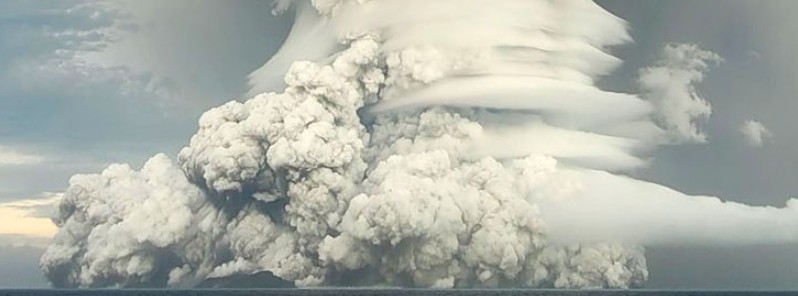The Hunga Tonga-Hunga Ha’apai volcano eruption on January 15, 2022, has set a new record for the greatest concentration of lightning ever detected. According to data from Vaisala’s Global Lightning Dataset GLD360, nearly 400 000 lightning events were detected within just six hours of the eruption, making it a truly exceptional phenomenon.
On January 15, 2022, the Hunga Tonga-Hunga Ha’apai volcano in the Pacific Ocean erupted, triggering over 600 000 lightning events. The eruption was the largest in over 100 years, and it caused significant damage to the Kingdom of Tonga and other Pacific states.
According to data from GLD360, around 200 000 lightning events took place on January 13 and 14 but the majority occurred on January 15, with nearly 400 000 events detected in just six hours.1
This made it the greatest concentration of lightning ever recorded, with at the peak of the eruption, nearly half of all global lightning concentrated around the volcano.
“In the December 2018 Anak Krakatau eruption, we detected about 340 00 events over a 1-week period, so to detect nearly 400 000 in just a few hours is extraordinary,” said Chris Vagasky, a meteorologist at Vaisala, a Finland-based environmental technology company.2
Around 56% of the lightning struck the surface of the land or ocean during the eruption.
“The percentage of lightning that was classified as cloud-to-ground was higher than you would normally see in a typical thunderstorm, and higher than you typically see in volcanic eruptions, so that creates some interesting research questions,” said Vagasky.
Data from Vaisala shows Tonga usually records only a few hundred lightning strikes in an entire year. But over the course of the eruption, more than 1 300 strikes hit the main island of Tongatapu alone.
The eruption also caused global tsunamis, which caused damage to the Kingdom of Tonga and other Pacific states.
Additionally, it threw enough water into the atmosphere to temporarily affect average temperatures around the world.
A new analysis published in the scientific journal Science in November 2022 has revealed that the eruption of the Hunga Tonga-Hunga Ha’apai volcano in Tonga on January 15, 2022, also created the highest volcanic cloud ever recorded. This is the first time a volcanic plume has been seen to penetrate the stratopause, the boundary layer between the stratosphere and the mesosphere.3
The research, led by Simon Proud, a National Centre for Earth Observation senior scientist at the University of Oxford and the Science and Technology Facilities Council’s RAL Space facility, used geostationary satellite images of the eruption to show that its volcanic cloud reached an altitude of 57 km (35.4 miles / 187 000 feet) above sea level at its highest extent.
The researchers were able to use parallax effect to triangulate the altitude using three geostationary weather satellite images located at 36 000 km (22 400 miles) up in space. The satellites were able to capture images every 10 minutes during the eruption, which allowed the scientists to document the rapid changes in the plume’s trajectory.
This high altitude of the volcanic cloud is particularly noteworthy as it means the plume reached the lower mesosphere. Prior to this, it was not known for volcanic eruptions to inject material through the stratosphere and directly into the mesosphere.
According to Dr. Proud, 30 years ago, when the Pinatubo volcano erupted, the satellites were not advanced enough to capture such detailed images as they do today. He suggests that the estimates for the height of the Pinatubo eruption may have been underestimated.
Furthermore, the eruption of Hunga Tonga-Hunga Ha’apai also had an interesting impact on the atmosphere. The eruption injected a significant amount of water into the mesosphere, which is usually a dry part of the atmosphere. This has made the eruption a valuable test case for understanding how well current climate and weather models can cope with unexpected and extreme conditions.
In the months following the eruption, New Zealand’s National Institute for Water and Atmospheric Research (NIWA) discovered that almost 10 km3 (2.4 mi3) of the seafloor was displaced during the eruption — with two-thirds coming from the summit and the rest from the surrounding flanks.3
Three-quarters of this material was deposited within 20 km (12.4 miles) of the volcano, which left almost 3.2 km3 (0.76 mi3) unaccounted for.
NIWA scientists have also unraveled one of the biggest unknowns of the eruption – the pyroclastic flows. Pyroclastic flows are currents made up of dense lava, volcanic ash, and gases that can reach temperatures of 1 000 °C (1 832 °F) and speeds of 700 km/h (435 mph).
Samples collected by NIWA showed pyroclastic deposits some 80 km (50 miles) away from the volcano. But Dr. Emily Lane, NIWA Principal Scientist – Natural Hazards, believes they could have traveled even further.
“Eighty kilometers was the end of our survey range, but the pyroclastic flows appear to extend beyond that distance, perhaps as far as 100 km (62 miles) away.”
They are also what caused both the domestic and international communications cables to break, with the domestic cable now being buried under 30 m (100 feet) of eruptive material.
1 Total Lightning Statistics 2022 – The Annual Lightning Report – Vaisala Xweather – January 2023
2 The perfect storm – Reuters – February 14, 2022
3 Hunga Tonga–Hunga Haʻapai eruption created the highest volcanic cloud ever recorded – The Watchers – November 6, 2022
4 The fullest investigation of the massive Hunga Tonga-Hunga Ha’apai eruption to date – The Watchers – November 21, 2022

